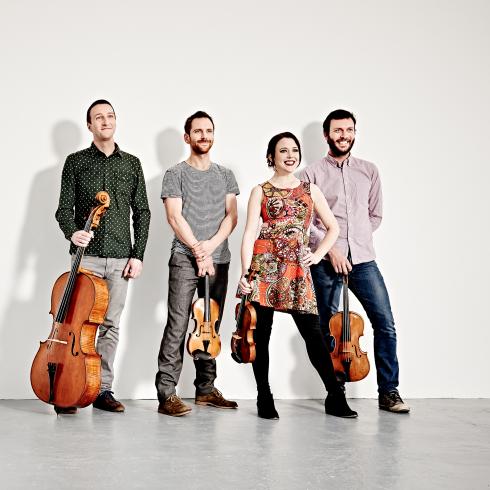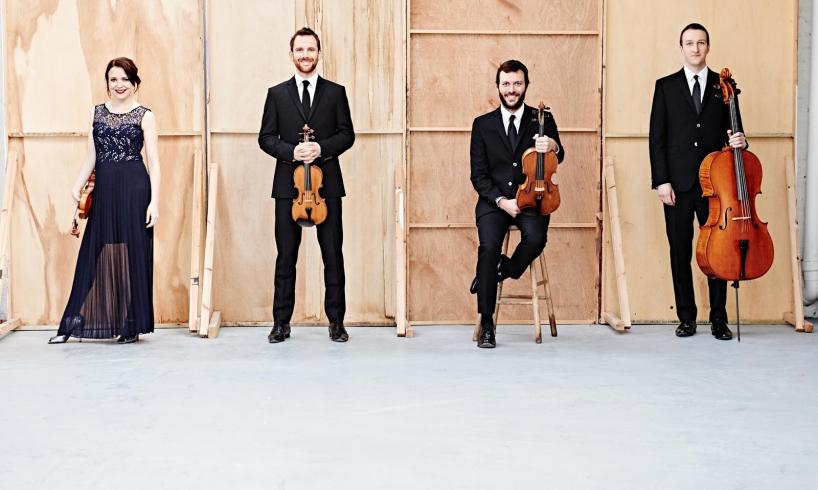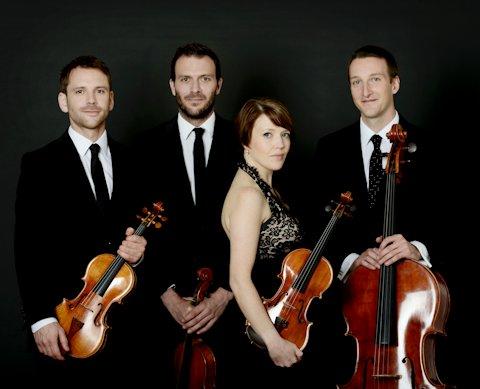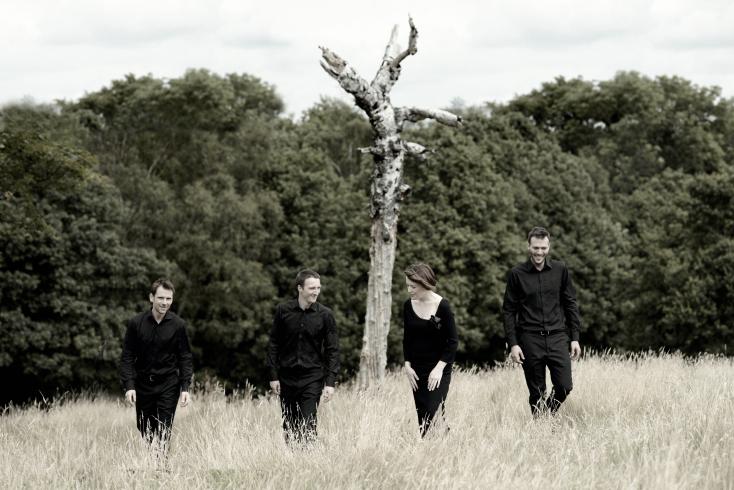Heath Quartet
String Quartet
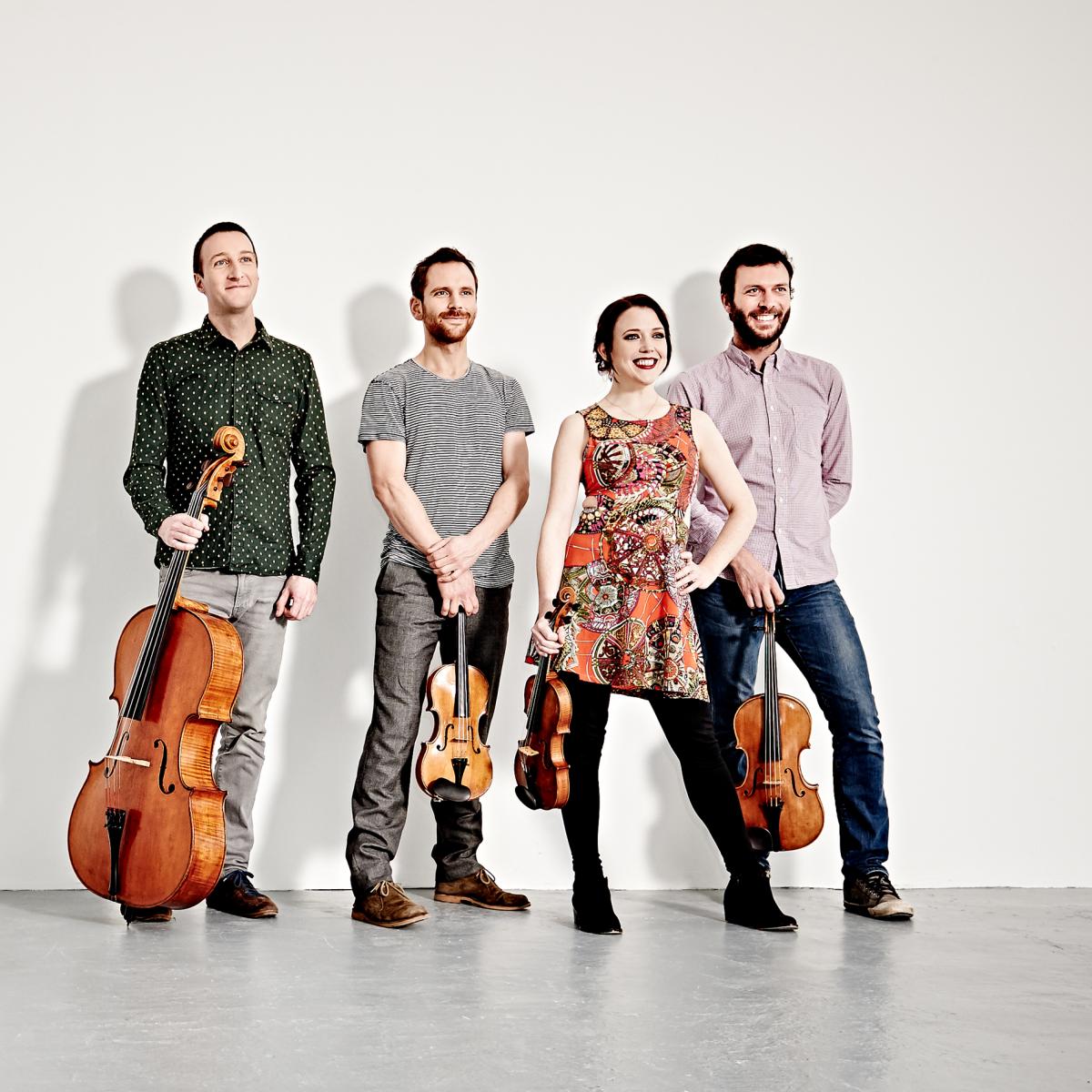
The British Heath Quartet will perform selections by Franz Joseph Haydn, Michael Tippett, and Antonin Dvořák.
Program
The British Heath Quartet was the winner of the first Young Artists Award from the Royal Philharmonic Society in 2013. Their concerts cover the whole range of quartet repertoire, with a particular interest in contemporary music. In this concert they present string quartets from three centuries and three countries. One of their first recordings was of Sir Michael Tippett’s cycle of five string quartets, made live at Wigmore Hall in London. Here they perform one of Tippett’s last works alongside Haydn at his most innovative, plus one of the pair of quartets that marked Dvořák’s farewell to chamber music.
PROGRAM:
FRANZ JOSEPH HAYDN (1732-1809)
String Quartet No. 39 in f-sharp minor, Op. 50, No. 4 (1787)
Allegro spiritoso
Andante
Menuetto: Poco allegretto
Finale: Fuga, allegro molto
MICHAEL TIPPETT (1905-1998)
String Quartet No. 5 (1992)
Medium Fast
Slow
Intermission
ANTONIN DVOŘÁK (1841-1904)
String Quartet No. 13 in G Major, Op. 106 (1895)
Allegro moderato
Adagio ma non troppo
Molto vivace
Finale: Andante sostenuto – Allegro con fuoco
About the Artists
The dynamic and charismatic Heath Quartet are fast earning a reputation as one of the most exciting British chamber ensembles of the moment. In May 2013 they became the first ensemble in 15 years to win the prestigious Royal Philharmonic Society’s Young Artists Award. Formed in 2002 at the Royal Northern College of Music they were selected for representation by YCAT, were awarded a Borletti-Buitoni Special Ensemble Scholarship and in 2012 won Ensemble Prize at the Festspiele Mecklenburg-Vorpommern.
The Heath Quartet’s 2015/16 season focuses heavily on the string quartets of Bartók, performing complete cycles at the Wigmore Hall, Brighton and Ryedale Festivals and at Middlebury College in Vermont, USA where they are in residence in early 2016.
Soon to be the proud owners of a fine discography, their debut CD will be released in autumn 2015 on the Wigmore Live label featuring the Tippett quartets, with their next two recordings to follow in 2016 on the Harmonia Mundi label featuring Tchaikovsky quartets (studio recording) and Bartók quartets (recorded live at the Wigmore Hall). Future highlights also include a return to the Kilkenny Festival performing the late string quartets of Mozart and to the Ryedale Festival for concerts based on T.S. Eliot’s Four Quartets, a project with the pianist Hannes Minnaar at the Concertgebouw in Amsterdam playing a French programme as well as numerous appearances at summer festivals in the United Kingdom and beyond.
Notable performances of the previous seasons have included a complete Beethoven Cycle at the Kilkenny Arts Festival, the world premiere of a John Tavener piece at the BBC Proms, concerts at the Beethovenfest Bonn, MecklenburghVorpommern Festival, the Concertgebouw Amsterdam and their debuts at the Musée d’Orsay and Louvre Auditorium in Paris. Regular visitors to the United States the quartet also recently made their debut in New York at both Carnegie Hall and the Lincoln Centre, and continue their residence at Middlebury College, Vermont.
In the UK they have also performed at the Barbican, Bridgewater Hall, Sage Gateshead, Perth Concert Hall and Queen’s Hall Edinburgh. And in Europe they have appeared at the Kissingen Winterzauber and Schwetzinger Festivals as well as deSingel Arts Centre in Antwerp, Vara Konserthus in Sweden, Berlin Konzerthaus, Esterházy Palace, and the Musikverein and Konzerthaus in Vienna.
The Heath Quartet regularly enjoy working with a host of talented collaborators including Anna Caterina Antonacci, James Baillieu, Ian Bostridge, Adrian Brendel, Michael Collins, Colin Currie, Stephen Hough, Sunwook Kim, Richard Lester, Joanna MacGregor, Aleksandar Madzar, Anthony Marwood, Mark Padmore, Lawrence Power, Carolyn Sampson, Jamie Walton and the Tokyo Quartet, plus even venturing into the world of jazz with a ‘Wigmore Late’ concert together with saxophonist Trish Clowes and pianist Gwilym Simcock.
Strong exponents of contemporary music, the Quartet have also worked with several leading composers including Hans Abrahamsen, Louis Andriessen, Brett Dean, Anthony Gilbert, Sofia Gubaidulina, Steven Mackey and John Musto. They took part in the European première of Steve Mackey’s ‘Gaggle and Flock’ for string octet, the world première of John Musto’s ‘Another Place’ with Carolyn Sampson at the Wigmore Hall as well as receiving unanimous critical acclaim for their performance of Ligeti’s Quartet No.2 and Thomas Ades’ ‘Arcadiana’ for The Park Lane Group at the Purcell Room.
The Heath Quartet members are Professors of Chamber Music at the Guildhall School of Music and Drama, individually holding instrumental teaching posts in the faculty.
Notes
Notes by Nigel Simeone
FRANZ JOSEPH HAYDN (1732-1809)
String Quartet in F-sharp minor, Op. 50, No. 4, Hob.III:47 (1787)
Haydn’s String Quartets Op. 33 were greeted with immense enthusiasm throughout musical Europe following their publication in 1782, notable for their “liveliest and most pleasing wit” according to one contemporary review, and leaving an audience in Hamburg “extraordinarily moved and delighted” according to another. But for the next five years there were no more Haydn string quartets. Artaria in Vienna offered Haydn a generous commission in 1784 (offering to pay him 300 florins) for a new set that could build on the tremendous three years, until the spring of 1787. In April 1787, Haydn sent King Friedrich Wilhelm II of Prussia his six “Paris” Symphonies. In return, “as a mark of His Highness’s satisfaction”, Haydn was sent a ring, a gesture which greatly touched him. A month later, on May 19, 1787, he gave Artaria a progress report on the new quartets: “I have already finished the 4th Quartet and will certainly send it next Friday.” He went on to discuss an appropriate dedication for the new quartets: “You know that I received a beautiful ring from His Majesty, the King of Prussia. I feel deeply in His Majesty’s debt because of this present, and I can think of no better and more fitting way of showing my thankfulness to His Majesty … than by dedicating the six quartets to him.” Haydn made steady progress on the remaining quartets, and by October, Artaria was able to prepare proofs. Meanwhile, he had already done a separate deal (including another fee) with William Forster in London, to publish the quartets there. Artaria finally published the Op. 50 Quartets, duly dedicated to Friedrich Wilhelm II. They have subsequently become known as Haydn’s “Prussian” Quartets. The London edition appeared at about the same time, with a dedication to the Duke of Cumberland, a noted musical amateur and supporter of Haydn.
The Quartet Op. 50 No. 4 – presumably the “4th Quartet” mentioned by Haydn in his letter of May 19, 1787, is one of the most original of the whole set. In the key of F-sharp minor, which Haydn rarely used, its mood is often tense, its language terse. The first movement is all acerbic energy rather than charm, especially so in the tautly-argued development section, though it ends in the warmer key of F-sharp Major. The Andante begins in A Major with the main song-like theme on the first violin. But even in this movement, Haydn cannot resist injecting some gritty material – a section in A minor ushered in by the cello which returns in varied form. The Menuetto is in F-sharp Major, though there are some characteristically adventurous excursions into other keys. The Trio section, in F-sharp minor, is thematically related – it’s almost like a development of the Menuetto theme, with the viola taking the lead at the start. The finale is a fugue based on a tortuous, thorny subject first heard on the cello. Unlike the first movement, there is no consoling or celebratory shift into a major key. Instead, this extraordinary movement remains implacable to the end.
MICHAEL TIPPETT (1905-1998)
String Quartet No. 5 (1992)
Tippett wrote five string quartets. The first three all date from the earlier part of his career (the Third was given its premiere in 1946). For the next thirty years there were no quartets – Tippett concentrated on operas and orchestral works – but in 1977–1978 he wrote a Fourth Quartet, and the present work dates from 1990–1991, when the composer was in his mid-eighties. Apart from The Rose Lake (for orchestra, finished in 1993), it is his last major work. The score is headed with a quotation from an old French folk song: “Chantes, rossignol, chantes, Toi qui as le coeur gai” – “Sing, nightingale, sing, you who have a happy heart.” For Tippett, the song of the nightingale could also resemble something more melancholy – he once said it “can sound like someone sobbing from heartbreak.” The quotation is thus a clue to the emotional range of this work – one that is filled with the wisdom of old age but that also has many passages that suggest a distinctly youthful spirit. There is great rhythmic energy in the faster music, especially in the first movement. The second movement was inspired by the late Beethoven quartets, in particular the “Heilige Dankgesang” from Beethoven’s Quartet in A minor Op. 132, to which there are some musical allusions. In this long movement the music is rather hesitant at first, but it gradually blossoms into something more lyrical. At the end, the singing line of the first violin becomes increasingly song-like, the harmonies are richer, and the final chord is both radiant and luminous. Tippett composed his Fifth Quartet for the Lindsay String Quartet – longtime champions of his music – who gave the first performance at the Crucible Theatre, Sheffield, on 9 May 1992.
ANTONIN DVOŘÁK (1841-1904)
String Quartet in G Major, Op. 106, B192 (1895)
At the start of his career Dvořák worked for ten years as an orchestral viola player and his official Op. 1 was a string quartet composed in 1861. Dvořák’s writing for string instruments has a character and sonority that is entirely original, demonstrating the results of his performing experience as well as his creative imagination. He composed fourteen string quartets and the last two, Op. 105 and Op. 106, were finished on consecutive days in December 1895.
Dvořák and his spent from September 1892 to April 1895 in the United States, as director of the National Conservatory of Music in New York City. His years in America were some of the most productive of his life, including the composition of the ‘American’ Quartet, the ‘New World’ Symphony and most of the Cello Concerto, as well as starting Op. 105, the companion work to the present quartet. When he returned to Prague in the spring of 1895, he did not immediately return to composing. He took four months off, relaxing at his summer house in Vysoká. To his friend Alois Gobl, he wrote: “I am basking in God’s nature and I am contentedly idle. I am not doing anything, which will probably surprise, but it’s true. I’m just lazing around and haven’t picked up my pen.” While Dvořák wasn’t writing anything, he was certainly developing ideas. The first work he started back in his homeland was the String Quartet in G Major Op. 106, which was completed in less than a month of concentrated activity, between November 11 and December 9, 1895 (the A-flat Major Quartet, already started in America, was finished the following day). The first performance of Op. 106 was given in Prague on October 9, 1896, given by the Czech Quartet (sometimes known as the Bohemian Quartet, the members of which had close links with the composer. The leader was Karel Hoffmann who formed the ensemble with friends at the Prague Conservatory. The second violin was the composer Josef Suk, not only a Dvořák pupil but also his son-in-law; the viola was played by the composer Oskar Nedbal, another Dvořák pupil; and the cellist was Hanuš Wihan, the dedicatee of Dvořák’s Cello Concerto.
The first movement opens with a leaping theme that is contrasted briefly with a mysterious idea, and then with a fully-fledged second theme that has an easy lyricism so typical of Dvořák. The development section is particularly ingenious, moving freely through an amazing range of keys, and treating fragments of both themes with astonishing inventiveness. The slow movement begins with a soulful theme that Dvořák elaborates with great eloquence, not least when the tune appears in a sun-drenched major-key variant. The ending is gentle and tender. The third movement is a Scherzo that has echoes of Dvořák’s American works. The energetic, driving main section is intercut with two Trio sections that are dominated by song-like themes and delicately colored textures. The finale is the most rhapsodic in terms of structure, starting with a slow introduction, before launching into a joyous dance-like theme that dominates a movement in which Dvořák also recalls music from earlier in the work before bringing this most genial and heartwarming of quartets to an exultant close.
